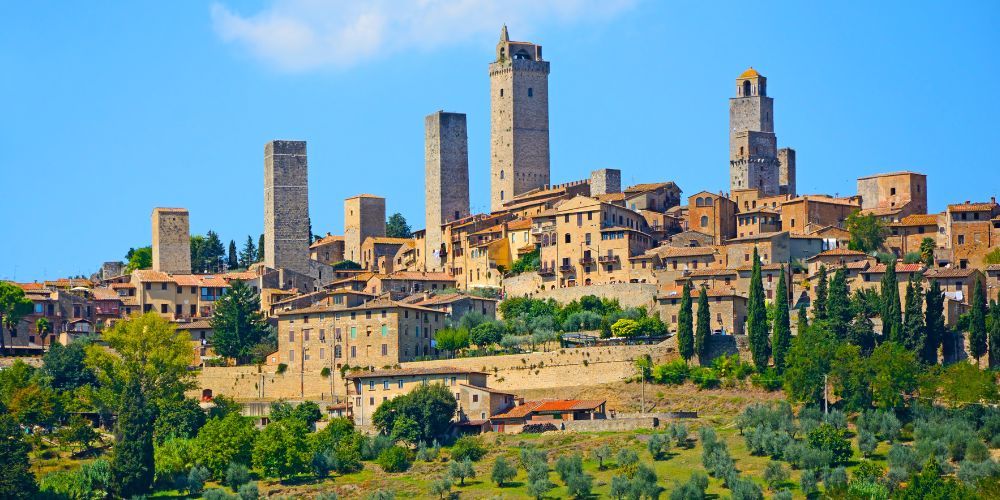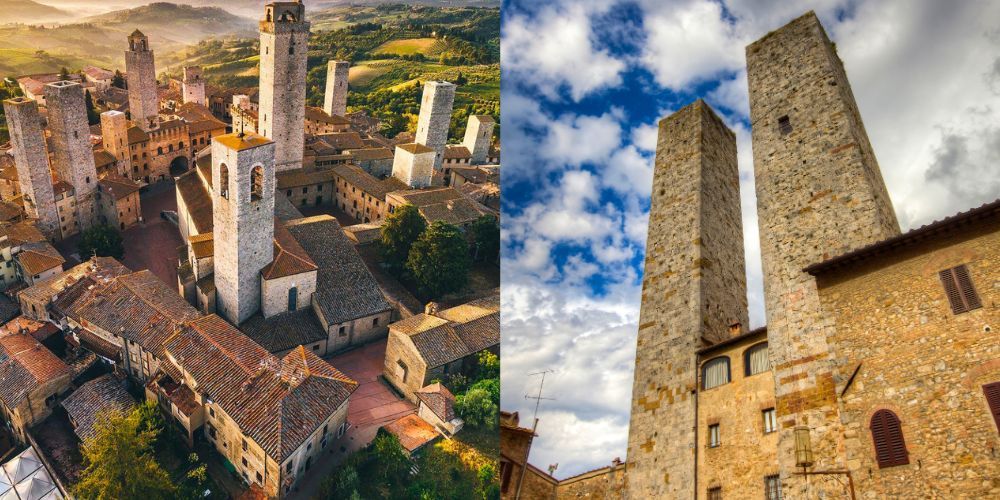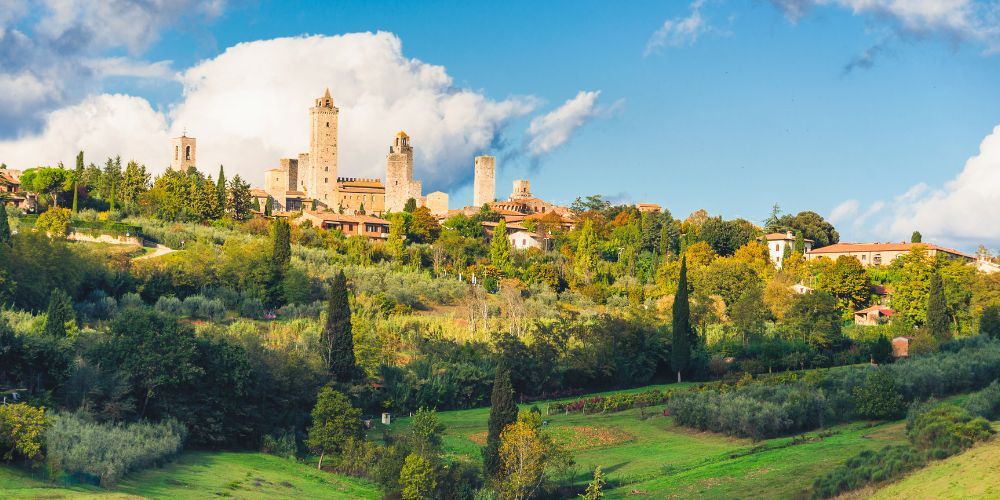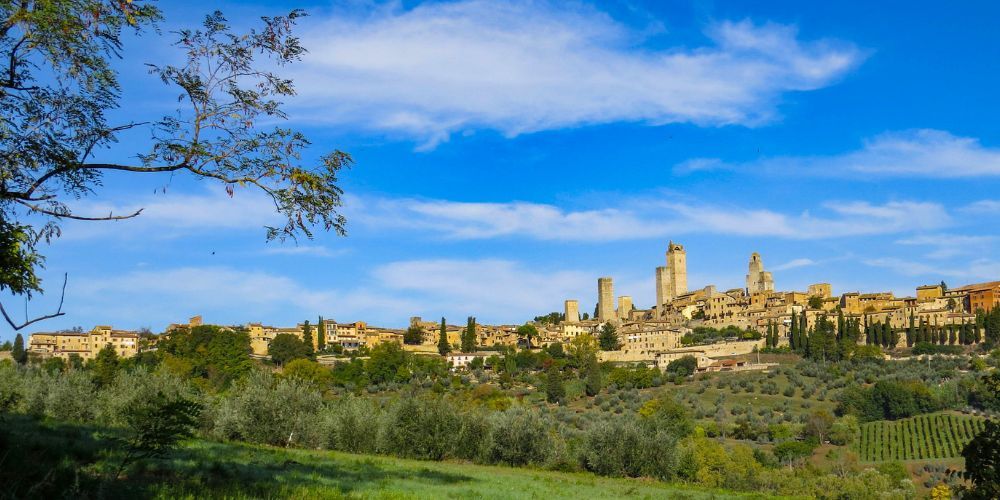Once known as "the town of 100 towers", and in hindsight today also defined as "the Manhattan of the Middle Ages", the ancient village of San Gimignano is one of the most beautiful gems of Tuscany, a treasure ofmedieval history, art and architecture that became part of the Unesco Heritage in 1990.
Its historic centre, perfectly preserved within the original walls and forged by centuries of challenges for prestige between noble families, stands on the top of a hill between Florence and Siena, like a real crown of bricks towards the sky. Today, however, only 14 towers still remain, but this doesn't detract from the charm of one of the most beautiful villages in Italy - and in the whole world.
Discover what to see in San Gimingnano in 2 days
What to see in San Gimignano

The historic centre of San Gimignano winds around the two main squares: Piazza della Cisterna, and the adjacent Piazza del Duomo. Together, these two squares and the surrounding buildings form a complex of enormous importance and beauty.
Piazza della Cisterna takes its name from the octagonal well that is still intact today, in the center of what used to be the heart of the town. Here there was the market, here the rides were held and here there was, and still is today, the Devil's Tower. The building owes its name to a legend according to which it was the devil himself who increased its height, one night when the owners were not at home.
In Piazza del Duomo, on the other hand, there is Palazzo del Popolo, one of the most important monuments of San Gimignano. Its Torre Grossa is the highest in town and is still the only one that does not belong to private families and therefore can be visited. Palazzo del Popolo also had an illustrious guest: Dante Alighieri, who stayed there during a diplomatic visit. His room can also be visited today. Not to be missed, and part of this very rich palace as well, is the Pinacoteca where you can admire the masterpieces of the Italian Renaissance, including those by Benozzo Gozzoli, Pinturicchio and Filippo Memmi.
In the Cathedral, which is right in front, there are also the precious frescoes by Ghirlandaio, in the chapel of Santa Fina.
Another church of great importance is that of San'Agostino, a few minutes from the Duomo. Inside there are works by Benozzo Gozzoli and Pollaiolo, as well as the wonderful majolica floor by Andrea della Robbia.
A walk through the alleys of San Gimignano, however, will inevitably lead you to discover suggestive views, small craft and gastronomy shops and to breathe the atmosphere of a place where time has stopped. With a short rise you can also reach the Rocca di Montestaffoli, once a defensive structure, today an amazing view point that also hosts cultural events.
A few steps from the center, beyond Porta delle Fonti, there are finally the Medieval Fountains, stone basins dug into the hillside and surmounted by twelve imposing arches.
Tuscany. Each hill a village. Each village a story. Each story a secret to tell.
The towers of San Gimignano

The towers of San Gimignano are some of the most majestic and fascinating examples of medieval Italian architecture, a symbol of power and prestige of the noble families who inhabited the city at the peak of its history, between 1200 and the beginning of 1400.
In the golden age of San Gimignano there were tens and tens of towers, erected to demonstrate the wealth and political influence of their owners. But today, only 14 of the original towers remained intact, standing out in the Tuscan sky like sentinels of the past.
Among the most important, Torre Grossa (Big Tower) certainly deserves a mention, the tallest with 54 meters height, and the Salvucci Towers - the Superior and the Minor - whose similarity to the New York’s Twin Towers, despite the clear differences, is impressive. The other towers to discover in San Gimignano are the Ardinghelli Towers, Becci Tower, Campatelli Tower, Chigi Tower, Cugnanesi Tower, Devil's Tower, Ficherelli or Ficarelli Tower, Palazzo Pellari Tower, Pesciolini Tower, Pettini Tower, Rognosa Tower and the Bell Tower of the Collegiate Church of Santa Maria Assunta.
This extraordinary urban landscape, futuristic for its time, has earned San Gimignano and its historic centre the pride of being part of the Unesco Heritage, attracting thousands of visitors every year curious to immerse themselves in a stunning atmosphere that mixes medieval charm with contemporaneity.
What to eat in San Gimignano

San Gimignano is not a Unesco site only for its precious artistic beauties, but for its culture as well, which is also made up of good food.
Not eating (and not drinking) well in Tuscany is pretty much impossible and San Gimignano is no exception. Given the proximity to Siena, this place is affected by the Sienese food and wine culture. You can therefore easily delight your palate with a long series of excellent quality cheeses and meats.
Do not miss the pecorino cheese, but also the Prosciutto Toscano Dop, or the "buristo" a salami made with pig's blood. The meat of cinta sense is also exquisite; it's a pig breed so widespread in these parts that it is also represented in the frescoes of the great artists.
And how not to mention the wild boar? It's one of the undisputed protagonists of local cuisine, excellent for making cold cuts and pasta sauces.
Saffron is also typical of San Gimignano. In the past centuries it has brought great wealth into the pockets of local merchants. The one produced in the surrounding countryside is so valuable that it was once used in exchange of money.
As for the wines, however, the most famous here is Vernaccia which can be tasted in many different labels. Do not miss the San Gimignano DOC, either Rosso, Rosato or Vinsanto. Equally valuable are the numerous Chianti DOCG wines and Toscana IGT wines, much loved and widespread here.
What to see near San Gimignano

San Gimignano is a hidden gem with the privilege of being within an extraordinary landscape, that of Tuscany. Even just strolling through the rolling hills that seem to be covered in soft green velvet is a great way to spend an unforgettable slow holiday.
For those who also want to explore all the art treasures that the area has to offer, there is plenty of choice. Siena is close, as is the wonderful Etruscan town of Volterra. Also not to be missed is the small Monteriggioni, which struck the imagination of Dante Alighieri.
Like San Gimignano, this tiny village is located on the Via Francigena too, the ancient pilgrims road. Trekking lovers, therefore, can also have fun walking along a stretch of it, to admire the unparalleled beauty of the Tuscan countryside.
Wine lovers and good living will certainly not miss out on a wine tasting experience in this area so famous for its wines. If you start from Florence, there are many tours that allow you to discover San Gimignano and surroundings while indulging in one or two glasses of wine.
Wine tasting and tour around San Gimignano starting from FlorenceHow to get to San Gimignano

San Gimignano, in the heart of Tuscany, does not have a train station or an airport, but it is still easily accessible. Here's how to get there:
The most convenient way to visit San Gimignano is by car, which is also ideal for exploring the surrounding landscapes. From Florence or Siena, just follow the SS67 or SS2 to Poggibonsi and then continue for about 15 km following the signs for San Gimignano. You can park conveniently in one of the car parks outside the walls, as the historic center is limited to traffic.
For those who prefer the train, the closest stations are Poggibonsi and Certaldo, both connected to Florence and Siena by regional trains. From these stations, you can take a local bus (line 130 from Poggibonsi) that goes directly to San Gimignano. It is advisable to check the timetables in advance, especially on holidays.
There are direct buses (Tiemme line) from Florence and Siena too, but the journey is longer than by car or train, as there are several stops along the way.
About the author
Written on 30/10/2024


Paola Cirino
Immersed in tuscan hills, between Florence and Siena, San Gimignano is a jewel of medieval history, art and architecture, Unesco Heritage since 1990.